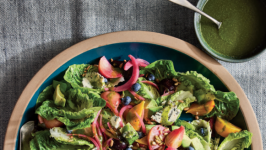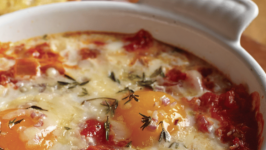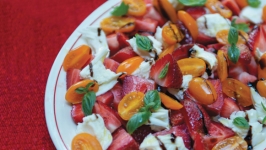Ingredients
- ¼ cup plus 1 tablespoon extra-virgin olive oil
- 1 pound asparagus, stalks cut into ½-inch pieces, tips intact (see Ingredient Info)
- 12 baby red radishes, halved or quartered, or 6 red radishes, cut into small bite-size wedges (heaping 1 cup)
- Fine sea salt and freshly ground black pepper
- Heaping 1 cup grilled marinated baby artichokes (7 to 9 ounces), drained and cut into bite-size pieces (see Butcher Tip)
- ½ cup pitted and halved green olives or kalamata olives
- 4 cups low-sodium vegetable stock
- 1 medium onion, ¼-inch diced (2 cups)
- 1 medium fennel bulb (12 ounces), cored and thinly sliced (2 cups)
- 4 garlic cloves, minced
- 1¼ teaspoons smoked sweet paprika
- 2 tablespoons tomato paste
- 1½ cups paella rice (see Ingredient Info)
- 1⁄3 cup plus a splash of sherry or dry white wine
- ½ teaspoon saffron threads
- 2 bay leaves
- ½ cup loosely packed fresh flat-leaf parsley leaves and thin stems, finely chopped (or 2 tablespoons minced chives)
- Lemon wedges, for serving
Preparation
Asparagus and Artichoke Paella
Recipe by Cara Mangini from her book The Vegetable Eater
Serves 6 as a main
INGREDIENT INFO: Avoid pencil-thin asparagus. Standard-size asparagus should be cut in ½-inch pieces. If using thicker asparagus, cut it on a diagonal into 1-inch slices. Cut jumbo asparagus into thin (¼-inch) rounds. Spanish paella rice is short-grained rice that soaks up liquid (flavor) gradually without becoming overly soft and sticky. Seek out Calasparra or bomba rice, or use Arborio rice in a pinch.
BUTCHER TIP: To use fresh baby artichokes, trim and peel 1 to 1½ pounds baby artichokes to reveal their tender, light green-yellowish leaves and heart. Halve or quarter them into bite-size pieces (see page 79). In step 1, add the artichokes to the skillet with 2 tablespoons olive oil and a generous pinch of salt. Sauté until they begin to soften, about 4 minutes, then add the asparagus and radishes, and sauté until all the vegetables are tender, 4 minutes more.
Instructions
1. Heat 1 tablespoon of oil in a large skillet over medium-high heat. Add the asparagus, radishes, ¼ teaspoon salt, and a few twists of black pepper. Cook, stirring occasionally, for 2 minutes. Add the artichokes and olives and continue to cook, stirring occasionally, until the asparagus and radishes are crisp-tender and the artichokes and olives are warmed through, another 2 minutes. Transfer the mixture to a bowl and set aside. Return the pan to the stovetop (off the heat).
2. In a medium saucepan, bring the stock to a gentle simmer and leave to barely simmer on the lowest setting.
3. Heat the remaining ¼ cup of oil in the just-used skillet over medium heat. Add the onion, fennel, and ½ teaspoon salt and cook, stirring occasionally, until they soften and become golden in places, 6 to 8 minutes. Stir in the garlic and cook, stirring, for about 30 seconds until fragrant. Stir in the smoked paprika until evenly combined, then stir in the tomato paste and cook, stirring, until broken up and evenly incorporated, about 1 minute.
4. Stir in the rice and ½ teaspoon salt and continue stirring to coat and briefly toast the rice, about 1 minute. Carefully add the wine plus a small splash more, briefly stirring and scraping the bottom of the pan to deglaze it. Crumble the saffron with your fingers and stir it in. If the wine needs to cook off further, continue to cook, stirring, for another minute. Carefully pour in the hot stock, add the bay leaves, and stir, scraping up any browned bits on the bottom of the pan. Use the spoon to evenly spread out the rice in the pan. Once the stock begins to simmer, reduce the heat to low and simmer very gently, without stirring, until much of the stock is absorbed, about 15 minutes.
5. Scatter the reserved vegetables evenly over the top without disturbing the rice. Continue to cook the rice for about another 3 minutes on low heat until almost all of the liquid has been absorbed and the rice is al dente. (If the rice needs a little more time to cook, cover with foil and cook for a couple of minutes more.) As soon as the rice is done, turn up the heat to medium and cook, rotating the pan to ensure even heat and prevent burning, to cook off any excess liquid and to lightly brown and crisp (not burn) the rice stuck on the bottom of the pan, another 2 to 7 minutes. You should hear some sizzling as the last of the liquid cooks off and the socarrat forms. This is the prized browned crust at the bottom of the pan. Stop when you slip a spoon beneath the rice in places and it catches on rice (and before it burns!). Cover with foil and let rest for 5 to 10 minutes.
6. Uncover the paella, adjust salt to taste, and top with parsley (or chives). Serve the paella directly out of the pan with lemon wedges around the edges or on the side.
VARIATIONS: This recipe can be adapted for other seasons. For each variation, keep the onion, fennel, and garlic base and replace the artichokes, asparagus, and radishes with 4 to 5 cups chopped vegetables.
SUMMER PAELLA: Saute a small, thinly sliced red and yellow bell pepper with the onion and fennel. Add 1 medium zucchini, cut into¼-inch half-moons, as a substitute for the asparagus, and cook off excess liquid. Add 1 cup diced fresh tomatoes and the olives to the almost cooked rice at the end.
FALL PAELLA: Add 3 to 4 cups roasted cauliflower or Romanesco (a medium to large head cut into small,bite-size pieces) along with ½ cup peas and the olives to the top of the rice just before it finishes cooking.
Excerpted from THE VEGETABLE EATER: The New Playbook for Cooking Vegetarian by Cara Mangini, photos by Erin Scott. Workman Publishing © 2024. Readers can purchase the book through Cara Mangini's website and everywhere books are sold.






